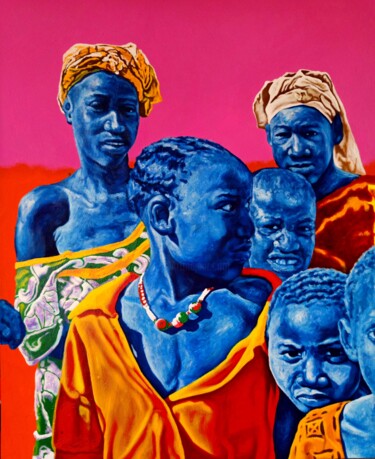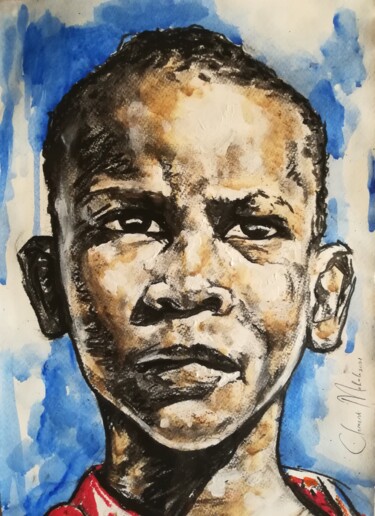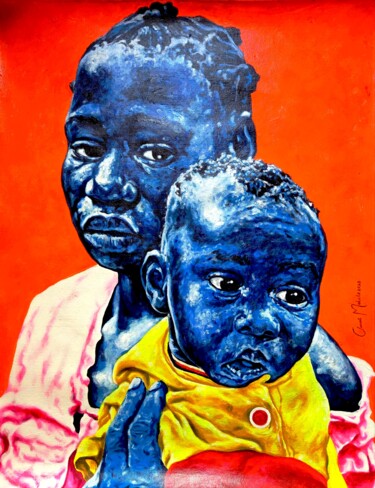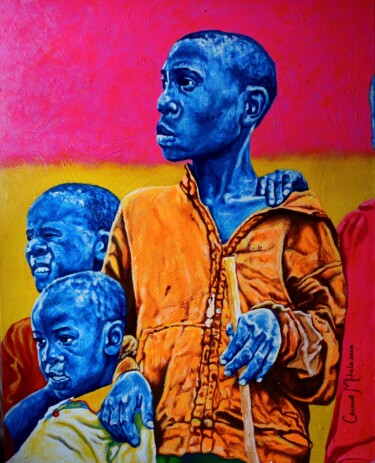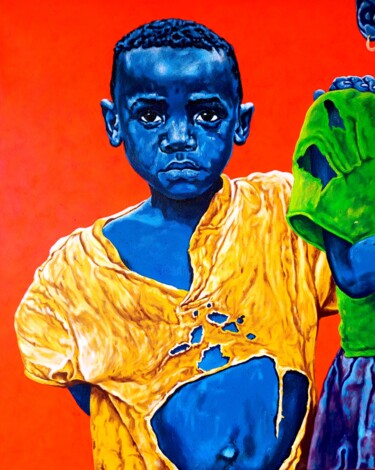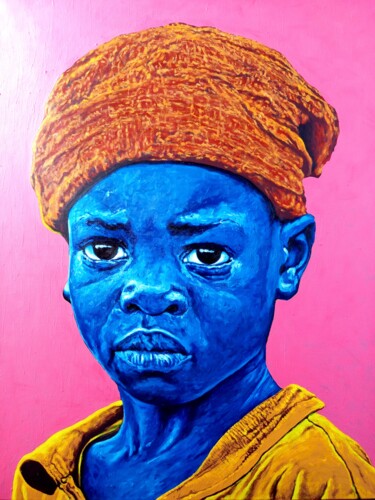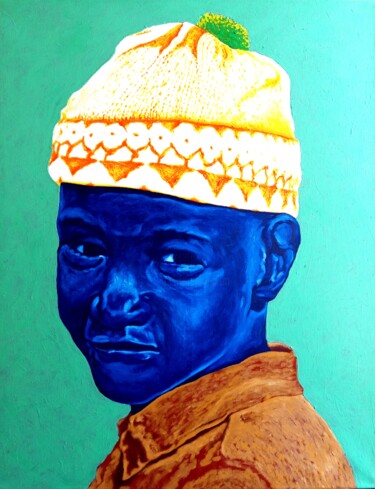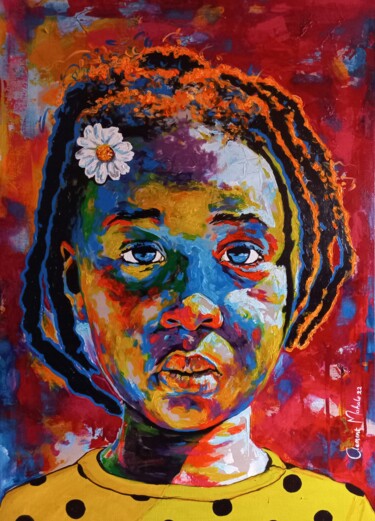Clement Mohale
Clement Mohale, a contemporary artist from South Africa, presents a body of work that is bold, vibrant, and deeply emotive. His artistic expression knows no bounds, utilizing a diverse array of mediums including charcoals, pastels, acrylics, and oil paints. In embracing a rich palette of basic colors, he skillfully conveys his ideas and emotions, refusing to confine himself to limitations in either medium or concept.
Inspired by the daily lived experiences that shape the human condition, Clement seeks to encapsulate the entirety of this multifaceted existence. Although his work draws from a spectrum of subjects, children frequently take center stage as powerful symbols of hope. Infused with elements from his family clan history, a crown emerges as a potent metaphor, symbolizing the acknowledgment of one's rights and the empowerment to make decisions for the greater good.
Juxtaposing the Johannesburg skyline as a metaphorical kingdom against his family's ancestral past, Clement weaves a narrative of revisiting roots while embracing a hopeful present. His focus delves into socio-political and economic issues, addressing critical matters such as poverty, homelessness, inadequate sanitation, and limited access to education. Through his art, Clement strives to illuminate how these issues significantly impact the well-being of ordinary individuals, prompting viewers to reflect on their own roles in creating a more equitable world.
Clement Mohale's work has garnered recognition and appreciation on an international scale, with collections spanning the U.S., Switzerland, Germany, England, and beyond. Beyond aesthetics, his art serves as a catalyst for introspection, encouraging viewers to engage with their own thoughts, feelings, and emotions. Ultimately, Clement's vision extends beyond the canvas, fostering a dialogue about societal challenges and inspiring collective efforts toward creating a better world for all.
Discover contemporary artworks by Clement Mohale, browse recent artworks and buy online. Categories: contemporary south african artists. Artistic domains: Painting, Drawing. Account type: Artist , member since 2021 (Country of origin South Africa). Buy Clement Mohale's latest works on ArtMajeur: Discover great art by contemporary artist Clement Mohale. Browse artworks, buy original art or high end prints.

Artist Value, Biography, Artist's studio:
African Pride • 17 artworks
View all'Shades of blues' • 25 artworks
View allSold Artworks • 31 artworks
Recognition
The artist has won prizes and awards
The artist has been published in the media, radio or TV press
The artist's works have been noticed by the editorial staff
The artist participates in art shows and fairs
Biography
Clement Mohale, a contemporary artist from South Africa, presents a body of work that is bold, vibrant, and deeply emotive. His artistic expression knows no bounds, utilizing a diverse array of mediums including charcoals, pastels, acrylics, and oil paints. In embracing a rich palette of basic colors, he skillfully conveys his ideas and emotions, refusing to confine himself to limitations in either medium or concept.
Inspired by the daily lived experiences that shape the human condition, Clement seeks to encapsulate the entirety of this multifaceted existence. Although his work draws from a spectrum of subjects, children frequently take center stage as powerful symbols of hope. Infused with elements from his family clan history, a crown emerges as a potent metaphor, symbolizing the acknowledgment of one's rights and the empowerment to make decisions for the greater good.
Juxtaposing the Johannesburg skyline as a metaphorical kingdom against his family's ancestral past, Clement weaves a narrative of revisiting roots while embracing a hopeful present. His focus delves into socio-political and economic issues, addressing critical matters such as poverty, homelessness, inadequate sanitation, and limited access to education. Through his art, Clement strives to illuminate how these issues significantly impact the well-being of ordinary individuals, prompting viewers to reflect on their own roles in creating a more equitable world.
Clement Mohale's work has garnered recognition and appreciation on an international scale, with collections spanning the U.S., Switzerland, Germany, England, and beyond. Beyond aesthetics, his art serves as a catalyst for introspection, encouraging viewers to engage with their own thoughts, feelings, and emotions. Ultimately, Clement's vision extends beyond the canvas, fostering a dialogue about societal challenges and inspiring collective efforts toward creating a better world for all.
-
Nationality:
SOUTH AFRICA

- Date of birth : 1994
- Artistic domains:
- Groups: Contemporary South African Artists

Ongoing and Upcoming art events
Influences
Education
Artist value certified
Achievements
Prizes and Awards
Collective Expositions
Permanent Collections
Publications & Press
Solo Expositions
Activity on ArtMajeur
Latest News
All the latest news from contemporary artist Clement Mohale
Clement Mohale by the-System *
. Can you state your name and describe what you do?
I am Clement Mohale a contemporary artist born in Bela-Bela, South Africa. Using oils and acrylics paints I create work that is bold, vibrant and emotive and it is inspired by my community and childhood memories.
. Your passion for art started in childhood, and you were mentored by the late Ernest Ditshego at The African Art Center. Can you tell us more about your early experiences with art and how Ernest Ditshego’s mentorship influenced your development as an artist?
My earliest memory of art dates back to primary school when I created a portrait of my parents, capturing their likeness. Their encouragement motivated me to keep practicing, and from that moment on, I was always drawing.
In 2007, I met my mentor, Mr. Ernest Ditshego, who inspired me to experiment and break artistic conventions. He once told me, “Clement, experiment freely even paint your subjects purple if you can.” At the time, I didn’t fully grasp his words, but years later, I find myself rendering my subjects in shades of blue. It feels as though he had foreseen my artistic path.
. Your work often features children as symbols of hope and addresses socio-political issues like poverty, homelessness, and access to education. How do you choose the subjects for your paintings, and what is the significance of using children in your artwork to convey these critical issues?
I choose the subjects for my paintings based on their untold stories. Their presence in my work highlights social issues in a deeply personal way.
By portraying children, I create a visual language that captures emotions beyond words, using shades of blue to reflect both struggle and strength. To me, they represent both vulnerability and potential. Through my work I challenge viewers to see their dignity and worth, not just as the future, but as the present.
. Your use of bold colors and strong light, especially in the context of monochrome and impasto techniques, is striking. How would you describe your artistic style, and how do you decide which techniques to use in order to communicate the emotional depth of your subjects?
My artistic style is bold, expressive, and emotive, blending realism and abstraction. I use monochrome blues to evoke memory, longing, and resilience, often juxtaposing my figures against vibrant backgrounds to create dynamic contrast.
I choose techniques based on the emotions I want to convey. Impasto textures add depth and presence, while strong lighting enhances contrast and expression. Loose, rhythmic brushstrokes bring movement and life to my compositions. Use of color, texture, and contrast is intentional, shaping the narrative of my work. My goal is to create a visceral, emotionally resonant experience for the viewer, using both acrylics and thick oil layers.
. How do you believe art can be a catalyst for change, and what role do you think artists play in advocating for social justice, particularly in addressing the inequalities you focus on in your work?
Art has the power to educate, encourage, and inspire change. It mirrors the artist’s world experience and the social challenges they have witnessed, and it is our noble role as artists to capture and recapture these experiences. In essence we are visual architects of the next generation, we archive the emotional and physical experience of our times, creating a sense of complex deeper conversations. Art creates a dialogue where information dissemination is limited, and the voiceless reside. Through my work, I aim to advocate for the dignity, rights, and empowerment of affected communities, sparking reflection and fostering a greater sense of social responsibility.
. Your work has been recognized internationally, with collections in the U.S., Switzerland, Germany, France, and beyond. How has this global recognition shaped your career and your perspective on the broader impact of your work?
International recognition of my work has expanded my reach, allowing me to engage with diverse audiences and highlighting art’s ability to connect people across boundaries. It has shifted my perspective, seeing my art as part of a larger dialogue on themes of hope, resilience, and social justice. This recognition motivates me to continue pushing my practice, knowing my work can provoke reflection and resonate globally.
. Much of your art explores themes of identity and inner struggle. How do your personal experiences shape the work you create, and how do you see your identity reflected in the art you produce? Are there particular memories or events that have had a profound influence on your artistic journey?
My personal experiences have had a profound impact on the work I create. As an artist who has experienced inner struggle, art became a sanctuary for me; a place where I could find stillness amidst the noise of the world. The loss of my father at a young age left a void that has remained with me, often manifesting as a deep, sullen feeling in my work. I express themes of memory, longing, and the passage of time, using art to communicate those emotions that words can’t quite capture.
My identity is woven onto every piece I create. It reflects both the personal struggles and the resilience I’ve encountered throughout my life. The themes of inner conflict and identity often show up in my work, where I explore the tension between the past and present, the known and unknown. These personal experiences, especially the loss of my loved ones serve as a foundation, constantly influencing my creative journey and shaping the narratives I want to tell through my art.
. Looking forward, what are some of the key themes or projects that you are excited to explore in your upcoming work? How do you envision the evolution of your art in the coming years, and what message or legacy do you hope your work will leave for future generations?
Currently, I am working on a project centered around climate change, specifically exploring how water scarcity is affecting the well-being of my community. This theme is deeply relevant, as environmental challenges continue to shape our present and future. Through my art, I aim to highlight these issues, spark dialogue, and inspire action toward sustainable solutions.
As my art evolves, it will continue to be influenced by new experiences and the shifting realities of our world. I see my work expanding in both subject matter and technique, incorporating more experimental elements while maintaining the emotional depth and storytelling that define my practice.
Ultimately, I want my art to provoke thought and drive change. I want it to serve as both a testament to our time and an affirmation to the next generation that a more just and equitable world is possible. My hope is that my work leaves a lasting impact; one that challenges perspectives, fosters empathy, and inspires people to create meaningful change.
. And finally how would you define the art scene in South Africa at the moment and what do you think can or should be done to improve the creative industries in Africa starting with your local scene?
The South African art scene is vibrant, with emerging artists bringing fresh perspectives and unique voices. Innovation and storytelling reflect the country’s diverse cultural and social landscapes. To strengthen the creative industries in Africa, art should be democraticised and be more accessible through public spaces, community exhibitions, and integration into daily life. Prioritizing arts education in schools will also help nurture future artists and art enthusiasts. Stronger support systems, including funding, mentorship, and international exposure, are essential for sustainable artistic careers. By fostering inclusivity and support, we can elevate the African art industry and provide artists with the platforms they deserve.
Reviews and comments
